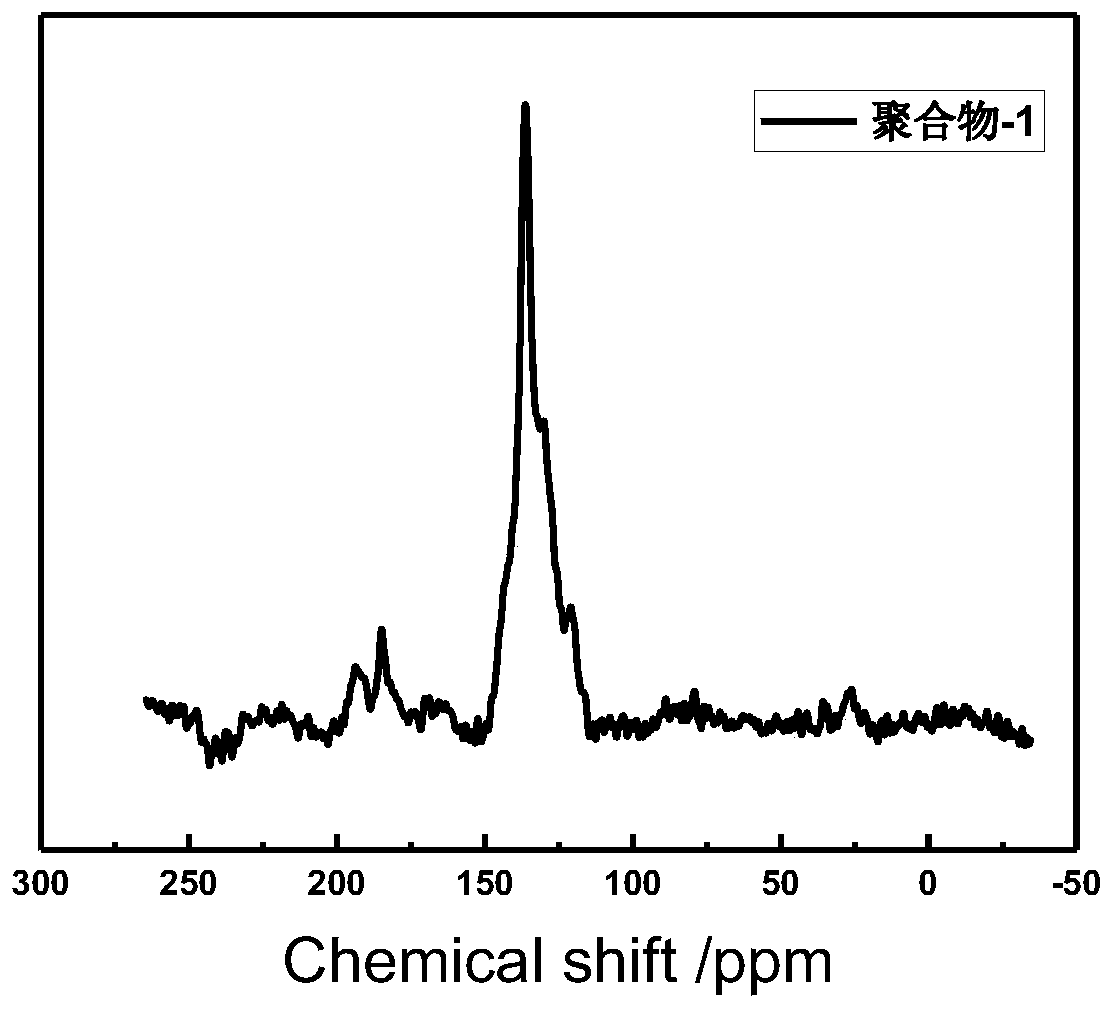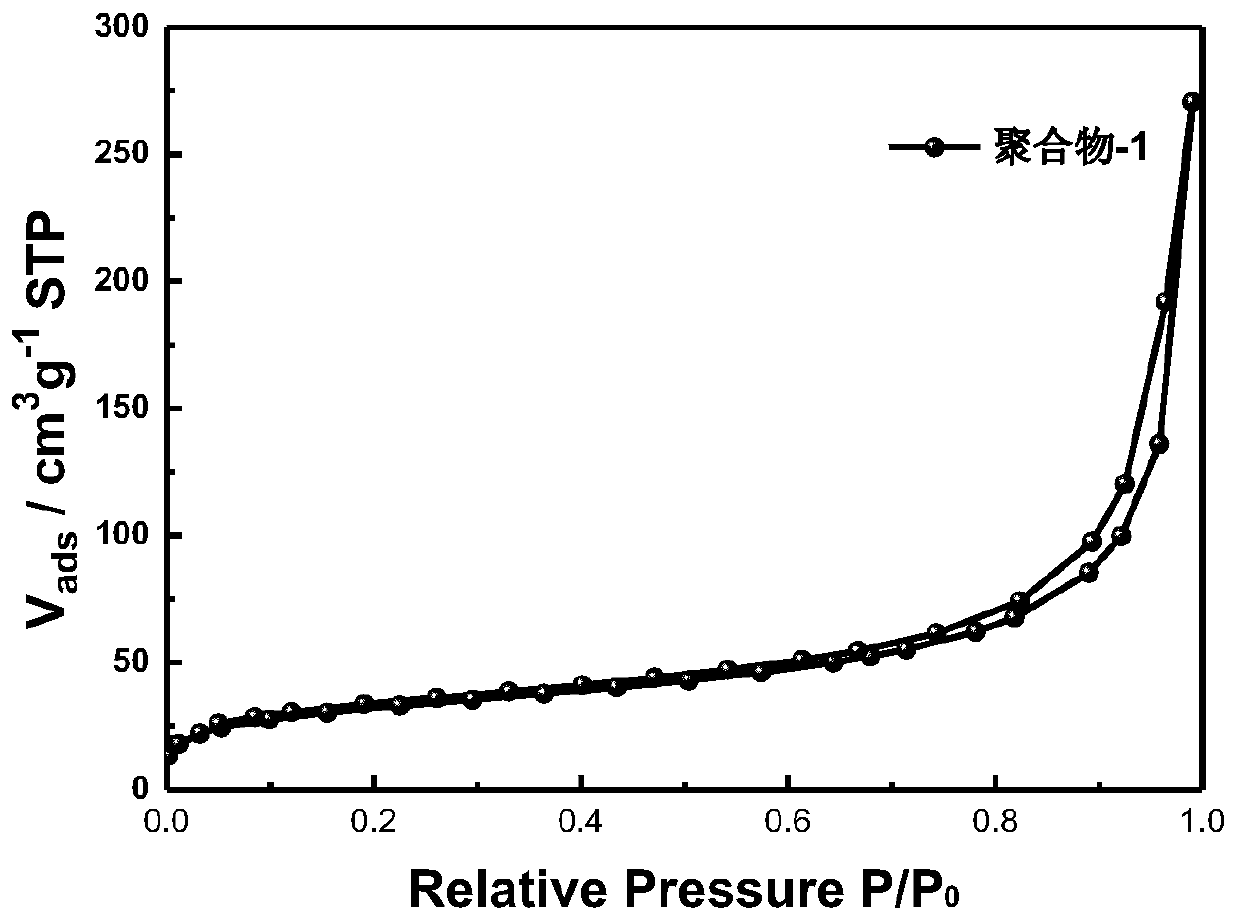Pyridyl-containing conjugated microporous polymer and preparation method and application thereof
A conjugated microporous, pyridyl-based technology, applied in chemical instruments and methods, and other chemical processes, can solve problems such as difficult reactions, harsh reaction conditions, and uncertainty in nitrogen content
- Summary
- Abstract
- Description
- Claims
- Application Information
AI Technical Summary
Problems solved by technology
Method used
Image
Examples
Embodiment 1
[0034] Combine trimesic aldehyde (162.1mg, 1mmol) and 1,3,5-triacetophenone (67.4mg, 0.33mmol) in a 50ml round bottom flask, add ammonium acetate (1.03g, 13.3mmol), and then add 25ml of acetic acid dissolves all the above-mentioned mixed powders, and finally the mixed solution is placed in an oil bath at 120°C and stirred at a certain speed for 8 hours. After the reaction, it was filtered with suction, first washed with ammonia water at room temperature for 24h, and then washed with deionized water and anhydrous methanol for 24h at 60℃. After suction filtered, it was dried in a vacuum oven at 60℃ for 24h. Pyridyl conjugated microporous polymer, denoted as polymer-1, its BET specific surface area is 111m 2 / g.
[0035] Of the polymer-1 obtained in this example 13 C-NMR test results such as figure 1 As shown, it can be seen that the peak at 136.5 ppm chemical shift is the peak of C in the pyridyl chemical environment, proving the existence of pyridyl; the peak at 130 ppm chemical ...
Embodiment 2
[0038] Combine trimesoaldehyde (162.1mg, 1mmol) and 1,3,5-triacetophenone (102.1mg, 0.5mmol) in a 50ml round bottom flask, add ammonium acetate (1.16g, 15mmol), and then add 25ml Acetic acid dissolves all the above-mentioned mixed powders, and finally the mixed liquid is placed in an oil bath at 120° C. and stirred at a certain speed for 8 hours. After the reaction is completed, filter with suction, first wash with ammonia water at room temperature for 24h, then wash with deionized water and anhydrous methanol for 24h at 60℃ respectively, and place it in a vacuum oven at 60℃ to dry for 24h after suction filtration. Pyridyl conjugated microporous polymer, denoted as polymer-2, its BET specific surface area is 106m 2 / g.
[0039] Of the polymer-2 obtained in this example 13 C-NMR test results such as image 3 As shown, it can be seen that the peak at 136.5ppm chemical shift is the peak of C in the pyridyl chemical environment, proving the existence of pyridyl; the peak at 121ppm ch...
Embodiment 3
[0042] Combine trimelliformaldehyde (162.1mg, 1mmol) and 1,3,5-triacetophenone (204.2mg, 1mmol) in a 50ml round bottom flask, add ammonium acetate (1.54g, 20mmol), and then add 25ml of acetic acid Dissolve all the above-mentioned mixed powders, and finally put the mixed liquid in an oil bath at 120°C and stir for 8 hours at a certain speed. After the reaction is completed, filter with suction, first wash with ammonia water at room temperature for 24h, then wash with deionized water and anhydrous methanol for 24h at 60℃, after suction filter, place it in a vacuum oven at 60℃ for 24h to obtain Pyridyl conjugated microporous polymer, denoted as polymer-3, its BET specific surface area is 30m 2 / g.
[0043] Of the polymer-3 obtained in this example 13 C-NMR test results such as Figure 5 As shown, it can be seen that the peak at 136.5 ppm chemical shift is the peak of C in the pyridyl chemical environment, which proves the existence of pyridyl; the peak at 130 ppm chemical shift is t...
PUM
 Login to View More
Login to View More Abstract
Description
Claims
Application Information
 Login to View More
Login to View More - R&D
- Intellectual Property
- Life Sciences
- Materials
- Tech Scout
- Unparalleled Data Quality
- Higher Quality Content
- 60% Fewer Hallucinations
Browse by: Latest US Patents, China's latest patents, Technical Efficacy Thesaurus, Application Domain, Technology Topic, Popular Technical Reports.
© 2025 PatSnap. All rights reserved.Legal|Privacy policy|Modern Slavery Act Transparency Statement|Sitemap|About US| Contact US: help@patsnap.com



